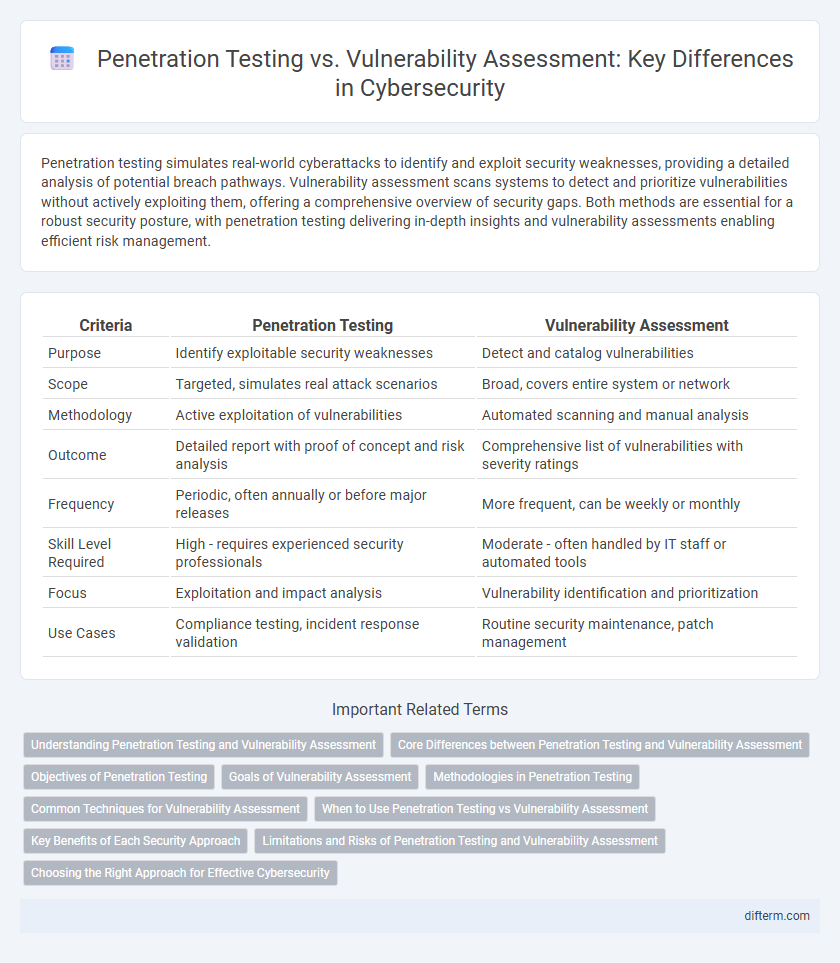Penetration testing simulates real-world cyberattacks to identify and exploit security weaknesses, providing a detailed analysis of potential breach pathways. Vulnerability assessment scans systems to detect and prioritize vulnerabilities without actively exploiting them, offering a comprehensive overview of security gaps. Both methods are essential for a robust security posture, with penetration testing delivering in-depth insights and vulnerability assessments enabling efficient risk management.
Table of Comparison
| Criteria | Penetration Testing | Vulnerability Assessment |
|---|---|---|
| Purpose | Identify exploitable security weaknesses | Detect and catalog vulnerabilities |
| Scope | Targeted, simulates real attack scenarios | Broad, covers entire system or network |
| Methodology | Active exploitation of vulnerabilities | Automated scanning and manual analysis |
| Outcome | Detailed report with proof of concept and risk analysis | Comprehensive list of vulnerabilities with severity ratings |
| Frequency | Periodic, often annually or before major releases | More frequent, can be weekly or monthly |
| Skill Level Required | High - requires experienced security professionals | Moderate - often handled by IT staff or automated tools |
| Focus | Exploitation and impact analysis | Vulnerability identification and prioritization |
| Use Cases | Compliance testing, incident response validation | Routine security maintenance, patch management |
Understanding Penetration Testing and Vulnerability Assessment
Penetration testing simulates real-world cyberattacks to identify exploitable vulnerabilities by actively attempting to breach systems, networks, or applications. Vulnerability assessment scans and catalogs security weaknesses, providing a prioritized list of risks without exploiting them, enabling organizations to understand potential entry points. Both methods are essential for comprehensive security strategies, with penetration testing offering in-depth exploitation analysis and vulnerability assessment delivering broad vulnerability visibility.
Core Differences between Penetration Testing and Vulnerability Assessment
Penetration testing simulates real-world cyberattacks to exploit vulnerabilities and assess the impact of successful breaches, providing a practical evaluation of security defenses. Vulnerability assessment identifies, quantifies, and prioritizes security weaknesses without actively exploiting them, offering a comprehensive inventory of potential risks. The core difference lies in penetration testing's active exploitation approach versus vulnerability assessment's passive identification and risk ranking.
Objectives of Penetration Testing
Penetration testing aims to identify security weaknesses by simulating real-world cyberattacks to evaluate an organization's defensive capabilities. The objective is to exploit vulnerabilities in systems, networks, or applications to assess the potential impact of a breach. This approach provides actionable insights for strengthening security measures and prioritizing risk remediation efforts.
Goals of Vulnerability Assessment
Vulnerability assessment primarily aims to identify, quantify, and prioritize security weaknesses across systems and networks to proactively reduce potential risks. It systematically scans for known vulnerabilities, misconfigurations, and missing patches to provide actionable insights for remediation. This process ensures organizations maintain compliance and strengthen their overall security posture by addressing issues before they can be exploited by attackers.
Methodologies in Penetration Testing
Penetration testing methodologies involve simulating real-world cyberattacks to identify exploitable security weaknesses, employing techniques such as reconnaissance, scanning, exploitation, and post-exploitation. These approaches emphasize hands-on testing with tools like Metasploit and Burp Suite to validate vulnerabilities under realistic conditions, enabling organizations to assess their security defenses effectively. Structured frameworks such as OWASP Testing Guide and NIST SP 800-115 provide systematic procedures for thorough penetration assessment, enhancing accuracy and reliability in identifying security gaps.
Common Techniques for Vulnerability Assessment
Common techniques for vulnerability assessment include automated scanning tools, manual configuration reviews, and network mapping to identify security weaknesses systematically. Tools like Nessus, OpenVAS, and Qualys provide comprehensive vulnerability databases and continuous updates for accurate detection. Vulnerability assessments focus on identifying, classifying, and prioritizing potential risks to facilitate remediation before exploitation occurs.
When to Use Penetration Testing vs Vulnerability Assessment
Penetration testing is ideal when organizations require an in-depth security evaluation to simulate real-world attacks and identify exploitable vulnerabilities that could lead to data breaches. Vulnerability assessment is best suited for regularly scanning networks and systems to detect and prioritize potential security weaknesses before they can be exploited. Use penetration testing when compliance requirements demand proof of security resilience, and vulnerability assessments for ongoing risk management and vulnerability tracking.
Key Benefits of Each Security Approach
Penetration testing identifies real-world attack vectors by simulating cyberattacks, revealing exploitable vulnerabilities and providing actionable remediation steps to improve an organization's security posture. Vulnerability assessment offers comprehensive scanning to detect a wide range of security weaknesses across systems and networks, enabling continuous monitoring and prioritization of risks based on severity. Combining both approaches enhances threat detection accuracy and strengthens overall defense strategies by addressing both exploitable gaps and potential vulnerabilities.
Limitations and Risks of Penetration Testing and Vulnerability Assessment
Penetration testing carries risks such as potential system crashes and data loss due to its intrusive nature, which can disrupt business operations. Vulnerability assessments, while safer, may fail to identify complex attack vectors or exploitation paths, leading to false negatives. Both methods are limited by the timing of the scan, often missing zero-day vulnerabilities and dynamic threats in real-time environments.
Choosing the Right Approach for Effective Cybersecurity
Penetration testing simulates real-world cyber attacks to identify exploitable vulnerabilities, providing a practical assessment of security defenses, while vulnerability assessments systematically scan and prioritize weaknesses for remediation. Selecting the right approach depends on organizational goals, with penetration testing offering deep insights into attack paths and vulnerability assessments enabling broad visibility of risks. Combining both methods enhances cybersecurity by balancing comprehensive detection with targeted exploit validation.
Penetration Testing vs Vulnerability Assessment Infographic

 difterm.com
difterm.com